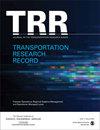Impact of Ball Bank Indicator on Predicting Rural Curve Crashes
IF 1.8
4区 工程技术
Q3 ENGINEERING, CIVIL
引用次数: 0
Abstract
The ball bank indicator (BBI) measures the lateral forces on a vehicle. It is used to establish the advisory speed limit as outlined in the American Association of State Highway and Transportation Officials (AASHTO)’s Green Book. BBI values respond to roadway geometry and driver behavior. Currently, BBI data are available from various curves across the U.S. However, the relationship between BBI and curve lane departures is unknown. Therefore, the objective of this paper is to assess the impact of BBI as an explanatory variable for curve lane departures within a safety performance function (SPF) (i.e., a crash prediction model). To accomplish this objective, a study is conducted on rural curves in Districts 1, 2, and 6 of Georgia Department of Transportation in the U.S. BBI is integrated into a negative binomial model alongside other common explanatory variables used in the Highway Safety Manual. This SPF, with BBI incorporated, is compared with a baseline SPF without the BBI. The results show BBI is a statistically significant variable under a 99.9% threshold. Additionally, it was found that the model with BBI has 2.78% and 2.83% less mean absolute error and route mean squared error, respectively. Though the improvement in the model is minor, this finding is notable because BBI data may already be available for a transportation agency to leverage to assess risk on curves. Furthermore, this data could be even more beneficial if it were crowdsourced to gauge real-world behaviors.球库指标对预测农村曲线崩溃的影响
球库指示器(BBI)测量车辆上的侧向力。它被用来建立美国国家公路和交通官员协会(AASHTO)的绿皮书中概述的咨询速度限制。BBI值与道路几何形状和驾驶员行为有关。目前,BBI数据来自美国各地的各种弯道。然而,BBI与弯道偏离之间的关系尚不清楚。因此,本文的目的是评估BBI作为安全性能函数(SPF)(即碰撞预测模型)中弯道偏离的解释变量的影响。为了实现这一目标,对美国乔治亚州交通部1、2和6区的农村弯道进行了一项研究。BBI与公路安全手册中使用的其他常见解释变量一起被整合到负二项模型中。这个包含BBI的SPF值与没有BBI的基线SPF值进行比较。结果表明,在99.9%的阈值下,BBI是一个具有统计学意义的变量。此外,研究发现,加入BBI后,模型的平均绝对误差和路径均方误差分别减少了2.78%和2.83%。虽然模型的改进很小,但这一发现是值得注意的,因为BBI数据可能已经可供运输机构利用来评估弯道风险。此外,如果通过众包来衡量现实世界的行为,这些数据可能会更有益。
本文章由计算机程序翻译,如有差异,请以英文原文为准。
求助全文
约1分钟内获得全文
求助全文
来源期刊

Transportation Research Record
工程技术-工程:土木
CiteScore
3.20
自引率
11.80%
发文量
918
审稿时长
4.2 months
期刊介绍:
Transportation Research Record: Journal of the Transportation Research Board is one of the most cited and prolific transportation journals in the world, offering unparalleled depth and breadth in the coverage of transportation-related topics. The TRR publishes approximately 70 issues annually of outstanding, peer-reviewed papers presenting research findings in policy, planning, administration, economics and financing, operations, construction, design, maintenance, safety, and more, for all modes of transportation. This site provides electronic access to a full compilation of papers since the 1996 series.
 求助内容:
求助内容: 应助结果提醒方式:
应助结果提醒方式:


